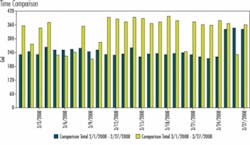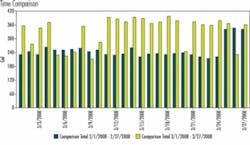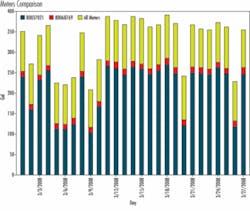Timely Data Access Helps Utilities Conserve Resources
by Peter Sanburn
As demand for water continues to increase and our finite supplies shrink, water providers are looking for ways to effectively manage operations and customer use to ensure their ability to deliver water to meet future consumer needs. Understanding who is using how much water and when the water it is used becomes an important capability when faced with resource constraints.
When advanced metering infrastructure (AMI) systems are combined with analytics software applications, such as with Water SaveSource™ from Itron, water providers are able to slice and dice meter information like never before, generating reports such as Daily Consumption Analysis, Hourly Trending, Usage Comparative Analysis, Leak Analysis and District Metering Studies.
To produce these advanced reports and understand where water is being used, it is vital to note the amount of water used and the time of usage. Intensifying water resource management challenges mean that water providers now need to collect a lot more data than they did in the past. It is still common for utilities to collect a meter reading every four months or even to estimate consumption to generate a quarterly water bill. Even managing a monthly consumption read for billing pales in comparison to collecting the granular data required for accurate data logging, a necessary capability to truly understand customer usage patterns.
With AMI systems, water providers are able to collect meter reads every day, every hour, or even every 15 minutes if desired. This amount of meter data is invaluable to understanding and managing customer usage, supporting conservation and increasing operational efficiencies.
While large amounts of granular data enable utilities to better define and manage usage, a new question arises. How is the mountain of data managed? It is one thing for a water provider with 50,000 customers to manage 50,000 monthly reads and pass the data to their CIS/Billing system. With an advanced Fixed Network or AMI system, the utility needs to consider the implications of managing hourly interval data for every customer, or the approximately 36 million reads a month. It is clear that a robust meter data management system (MDM) is required.
“The water industry has a history of being slow to move on technology,” said Darron Poulsen, customer service manager for the Cucamonga Valley Water District. Cucamonga is installing Itron’s MDM system to manage the data coming in from the Water SaveSource network there.
“But I am beginning to see that MDM is on people’s radar now—everybody knows we have to do this, but there is a bit of trepidation to get out there first. It is going to happen.”
Leveraging years of meter data management expertise in the energy industry, Itron has integrated the same database structure and query tools with specific water criteria and an intuitive user interface to generate in-depth analysis and reports concerning water consumption.
The MDM system also was designed to match the level of IT resources cities and municipal utilities have in place to ensure simplified implementation, operation and maintenance for the long term. The software easily stores and manages the millions of data points that AMI water systems collect. Access to the data across the utility, and storage of such data in a single repository, enables various parties to leverage the data for specific needs, from the meter shop, customer service, engineering, finance and managerial staff.
The MDM software runs the large amounts of data that’s collected and brought up through SaveSource through a series of smart applications. Some of the smart applications are trending analysis, either hourly or daily, to help manage compliance with conservation programs and profiling study programs; time-of-use billing for usage behavior modification; comparative analysis of usage patterns and district metering for leak detection. These applications can be applied to one meter or customer, or they can be aggregated over the entire meter base, enabling system-wide analysis. Custom analysis and reports can be written for specific attributes, depending on the provider’s requirements.
The prime example of an MDM application is water conservation management. Conservation can be achieved by either shifting flow or reducing consumption. A water provider may want to shift outdoor usage from high-evaporation periods to cooler times in the day to increase effectiveness of use. After creating a baseline of usage and implementing the program, the utility is able to use MDM applications to compare water usage, either by grouping or other variables, to determine the program’s effectiveness. Watering on even or odd days is a familiar type of conservation program and one that can be easily monitored for effectiveness and compliance with MDM software.
Time-based rates can influence consumption behavior for conservation needs and help to displace peak flows and optimize electricity consumption. To run hourly meter data against distinct hourly rates for billing requires the robust and discrete processing capabilities found in MDM software. When rate programs are synchronized with the energy suppliers peak pricing programs, water providers can benefit by a reduction in pumping needs and subsequent electricity required to run the pumps. This can lower their exposure to high energy costs associated with peak pricing periods.
“Conservation is vital and MDM is the key, with the quickest way to make an impact on our resources,” said Poulsen. “What we ultimately envision is the ability for the customer to see their usage information and respond. When the customer calls us, we will have all the granular data right in front of us instead of guessing.”
In addition to conservation efforts, Poulsen says MDM also improves customer service. Customer service representatives investigating a high-bill complaint can easily review the customer’s detailed consumption and identify specific usage over a period of time. The questioned usage can also be compared against the average for all customers or against an aggregate of neighborhood usage to determine any variance. The utility has a baseline for each customer.
System engineers benefit from MDM software with the ability to right-size meters and optimize utilization of field assets. By collecting and analyzing meter reads utilities can determine if the meter is over- or under-utilized.
A powerful aspect of the Itron MDM software is its storage capacity. The database is able to store hourly data from every customer meter for up to 10 years. This affords the water provider the ability to perform historical review and analysis on consumption and usage patterns to help manage supply issues against changes in usage and resource planning.
Much of the discussion around AMI systems is the collection and communication technology. While collecting the data and the communication network are the basis of these advanced metering systems, it is the intelligence in the software that converts the AMI data into valuable and actionable knowledge the water providers can use to help manage water usage and resources. Without meter data management software, the collected meter data is little more than a mountain of unmanageable data.
About the Author:
Peter Sanburn is a Marketing Manager for Itron Inc., based in Spokane, WA. Sanburn works directly with the Water Group and his responsibilities include developing the strategic positioning for the company’s advanced metering solutions for water.


